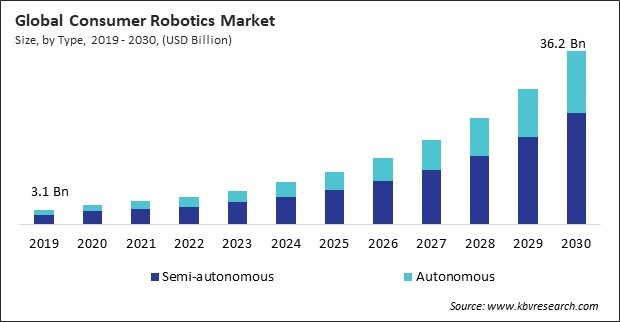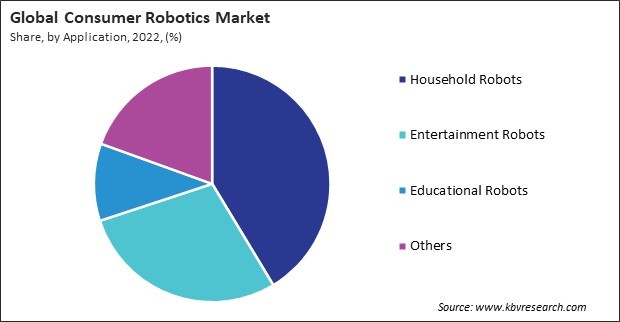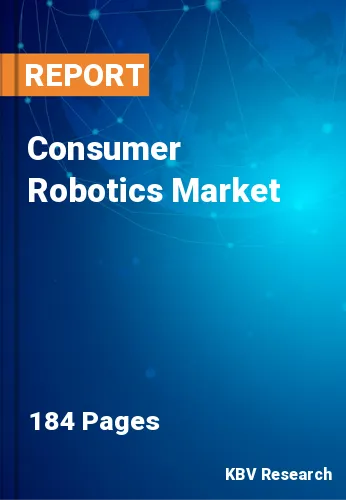“Global Consumer Robotics Market to reach a market value of USD 36.2 Billion by 2030 growing at a CAGR of 26.2%”
The Global Consumer Robotics Market size is expected to reach $36.2 billion by 2030, rising at a market growth of 26.2% CAGR during the forecast period.
AI-powered consumer robots can navigate dynamic and unpredictable environments with agility. Thus, the Autonomous segment acquired $1,974.2 million in 2022. This is achieved through real-time surroundings analysis, allowing robots to adjust their paths and actions based on changing conditions. ML algorithms enable robots to identify obstacles quickly and dynamically plan alternative routes. This ensures smooth and safe navigation, particularly in crowded or cluttered spaces. Integration of natural language processing (NLP) capabilities allows consumer robots to understand and respond to human voice commands naturally. This fosters intuitive communication, making the interaction between humans and robots more seamless and user-friendly.

AI algorithms empower consumer robots to learn from their experiences and adapt to various scenarios. This learning process enables robots to enhance their performance and efficiency continuously. Advanced AI enables robots to recognize and interpret complex patterns, facilitating an improved understanding of the environment. This, in turn, enables more accurate decision-making and responses to diverse situations. Additionally, Consumer robots are designed to integrate seamlessly into existing smart home ecosystems. They can communicate with other smart devices, creating a cohesive network that facilitates synchronized and automated actions within the home environment. The compatibility of consumer robots with various smart home devices ensures a holistic approach to automation. This interoperability enables users to control multiple devices through a centralized platform, simplifying the management of their connected environment. IoT-enabled robots can leverage data from various connected devices to optimize task scheduling. They can adapt their actions based on occupancy patterns, energy consumption, and other relevant parameters. Therefore, owing to these factors, the market will expand rapidly in the upcoming years.
However, consumer robotics encounters a substantial hurdle in the form of elevated manufacturing expenses. Integrating cutting-edge robotic technologies, advanced sensors, and specialized materials contributes significantly to the overall production costs. This obstacle directly affects the product's ultimate cost, which may prevent the average consumer from affording it. Production costs are increased due to the extensive research, development, and implementation required to incorporate cutting-edge robotic capabilities. Incorporating sophisticated sensors, including LiDAR and high-resolution cameras, improves a robot's interaction and perception capabilities; however, this increases the overall production cost. The affordability gap may impede the adoption of consumer robotics, limiting the technology's penetration into diverse households. Hence, owing to these factors, there will be decreased demand for consumer robotics in the coming years.
On the basis of application, the market is divided into household robots, entertainment robots, educational robots, and others. The household robots segment recorded the maximum revenue share in the market in 2022. Household robots now go beyond just cleaning. Innovations have led to the development of robots for tasks such as lawn mowing, pool cleaning, window washing, and even assistance in the kitchen. The expansion of applications contributes to the versatility and appeal of household robots. Thus, there will be increased growth in the segment.

Based on type, the market is segmented into autonomous and semi-autonomous. The autonomous segment held a considerable revenue share in the market in 2022. Integrating autonomous consumer robots with smart home ecosystems has contributed to their growth. Consumers can control and monitor these robots remotely through smartphone apps, and some devices can integrate with voice-controlled virtual assistants, enhancing overall convenience. Thus, these factors will pose lucrative growth prospects for the segment.
Free Valuable Insights: Global Consumer Robotics Market size to reach USD 36.2 Billion by 2030
By region, the market is segmented into North America, Europe, Asia Pacific, and LAMEA. The Europe segment procured the highest revenue share in the market in 2022. European consumers have noticed a notable increase in awareness and understanding of consumer robotics. This awareness and a growing acceptance of robotic technologies have contributed to increased adoption in both residential and commercial settings. Therefore, these factors will assist in the expansion of the segment.
| Report Attribute | Details |
|---|---|
| Market size value in 2022 | USD 5.7 Billion |
| Market size forecast in 2030 | USD 36.2 Billion |
| Base Year | 2022 |
| Historical Period | 2019 to 2021 |
| Forecast Period | 2023 to 2030 |
| Revenue Growth Rate | CAGR of 26.2% from 2023 to 2030 |
| Number of Pages | 184 |
| Number of Tables | 260 |
| Report coverage | Market Trends, Revenue Estimation and Forecast, Segmentation Analysis, Regional and Country Breakdown, Porter’s 5 Forces Analysis, Company Profiling, Companies Strategic Developments, SWOT Analysis, Winning Imperatives |
| Segments covered | Type, Application, Region |
| Country scope |
|
| Companies Included | iRobot Corporation (Amazon.com, Inc.), LG Electronics, Inc. (LG Corporation), Neato Robotics, Inc. (Vorwerk & Co. KG), Samsung Electronics Co., Ltd. (Samsung Group), Google LLC (Alphabet Inc.), Honda Motor Co. Ltd., Hasbro, Inc., Intuitive Surgical, Inc., Ecovacs Robotics Co., Ltd., Blue Frog Robotics, Inc. (Blue Frog Robotics SAS) |
By Type
By Application
By Geography
This Market size is expected to reach $36.2 billion by 2030.
Technological developments in artificial intelligence and machine learning are driving the Market in coming years, however, High manufacturing costs of consumer robotics restraints the growth of the Market.
iRobot Corporation (Amazon.com, Inc.), LG Electronics, Inc. (LG Corporation), Neato Robotics, Inc. (Vorwerk & Co. KG), Samsung Electronics Co., Ltd. (Samsung Group), Google LLC (Alphabet Inc.), Honda Motor Co. Ltd., Hasbro, Inc., Intuitive Surgical, Inc., Ecovacs Robotics Co., Ltd., Blue Frog Robotics, Inc. (Blue Frog Robotics SAS)
The expected CAGR of this Market is 26.2% from 2023 to 2030.
The Semi-autonomous segment is leading the Market by Type in 2022; there by, achieving a market value of $23.2 billion by 2030.
The Europe region dominated the Market by Region in 2022, and would continue to be a dominant market till 2030; there by, achieving a market value of $13.3 billion by 2030.
Our team of dedicated experts can provide you with attractive expansion opportunities for your business.

 Drivers
Drivers
 Restraints
Restraints
 Opportunities
Opportunities
 Challenges
Challenges
